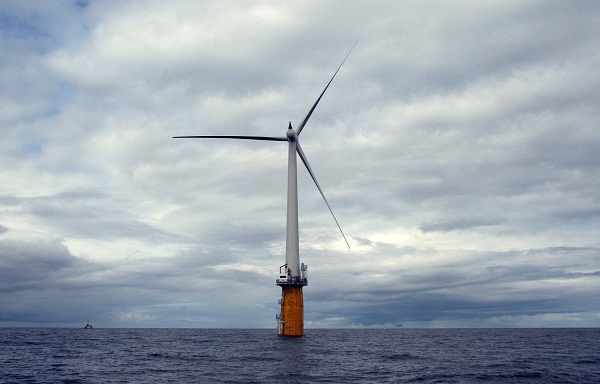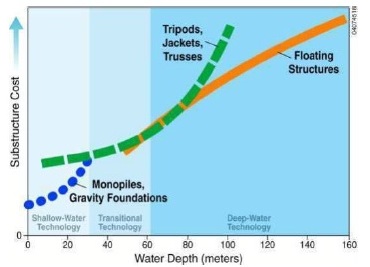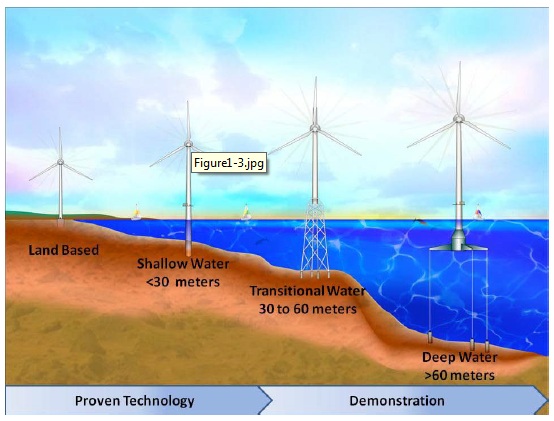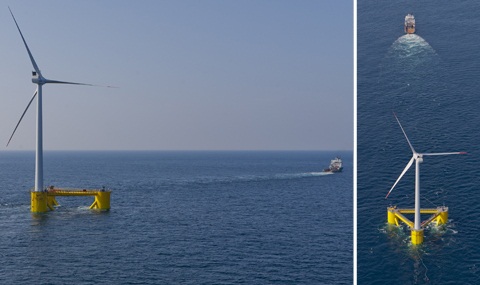The strongest, most consistent offshore winds are in deep water – but it’s prohibitively costly and difficult to put up traditional turbines in waters beyond perhaps 30 meters deep. Floating turbines are a potential solution to this dilemma, and now there are solid signs they might come to U.S. waters.
The Bureau of Ocean Energy Management on Thursday said it would begin formal assessment of Statoil North America’s request for a lease to build a demonstration project of full-scale floating wind turbines about 12 miles off the Maine cost.

Statoil is a serious player; it owns what appears to be one of just two floating turbines deployed in the world right now, the Hywind project off the Norway coast in the North Sea. It’s been operating, apparently without issue, since 2009.
The Maine plan from Statoil grows out of a 2010 Maine Public Utilities Commission request for proposals to build “deep-water offshore wind energy” projects “no less than 10 nautical miles” off the state’s famous coast. Not only are the wind conditions better farther off the cost, the potential for conflicts with other ocean interests is also minimized. The thinking is that the only way to access those winds is through floating turbines — other substructures would be just too expensive to be feasible.

The Obama administration is by all indications interested in promoting floating turbines even as the U.S. struggles to get in the offshore wind game at all (Europe has 4.3 gigawatts of offshore wind capacity installed; the U.S. has zero).
In April, the U.S. and U.K. agreed to work together on advancing the technology. In March, the U.S. Department of Energy announced a six-year, $180 million program to fund offshore demos, with floating turbines among the targeted projects. In an earlier funding announcement, $6.45 million out of $43 million granted went to four projects that involved floating platforms in one way or another.

The DOE is also among the backers of the DeepCwind Consortium at the University of Maine, in Orono, which has among its objectives the design and deployment of a demonstration floating wind turbine between 10 and 250 kilowatts in size.
“This is the first time that this innovative floating technology is being considered for development in deeper waters offshore our coasts,” Deputy Secretary of the Interior David J. Hayes said in the BOEM announcement.
Statoil wants to build the four-turbine, 12-megawatt project in an area covering about 22 square miles off Boothbay Harbor, which is about 50 miles up the Maine Coast (as the seagull flies) from Portland, Maine.
Statoil’s Hywind turbine off Norway is 65 meters tall, weighs 138 tons and floats in waters 200 meters deep, moored to the seafloor by three lines. An undersea cable connects the 2.3-megawatt turbine to the mainland. The company says that in 2010, it produced 7.3 gigawatt-hours of power, giving it a very respectable capacity factor of 36 percent.

The other significant ongoing floating wind turbine project is WindFloat, a joint project inolving Princeple Power, Energias Portugal and Vestas, among others, that was deployed late last year off the coast of Portugal. Partnership reported in June that the 2 MW turbine had “aready produced in excess of 1.7 GWh.”
On the Maine project, the BOEM’s notice of intent to prepare an environmental impact statement opens the project up for comment for 90 days from publication in the Federal Register, and gives other companies 60 days to submit a competitive interest in the lease area. More information is available on the BOEM website.